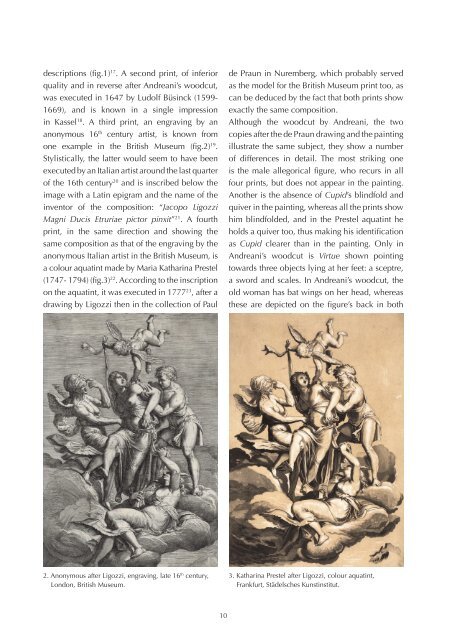You also want an ePaper? Increase the reach of your titles
YUMPU automatically turns print PDFs into web optimized ePapers that Google loves.
descriptions (fig.1) 17 . A second print, of inferior<br />
quality and in reverse after Andreani’s woodcut,<br />
was executed in 1647 by Ludolf Büsinck (1599-<br />
1669), and is known in a single impression<br />
in Kassel 18 . A third print, an engraving by an<br />
anonymous 16 th century artist, is known from<br />
one example in the British Museum (fig.2) 19 .<br />
Stylistically, the latter would seem to have been<br />
executed by an Italian artist around the last quarter<br />
of the 16th century 20 and is inscribed below the<br />
image with a Latin epigram and the name of the<br />
inventor of the composition: “<strong>Jacopo</strong> <strong>Ligozzi</strong><br />
Magni Ducis Etruriae pictor pinxit” 21 . A fourth<br />
print, in the same direction and showing the<br />
same composition as that of the engraving by the<br />
anonymous Italian artist in the British Museum, is<br />
a colour aquatint made by Maria Katharina Prestel<br />
(1747- 1794) (fig.3) 22 . According to the inscription<br />
on the aquatint, it was executed in 1777 23 , after a<br />
drawing by <strong>Ligozzi</strong> then in the collection of Paul<br />
de Praun in Nuremberg, which probably served<br />
as the model for the British Museum print too, as<br />
can be deduced by the fact that both prints show<br />
exactly the same composition.<br />
Although the woodcut by Andreani, the two<br />
copies after the de Praun drawing and the painting<br />
illustrate the same subject, they show a number<br />
of differences in detail. The most striking one<br />
is the male allegorical figure, who recurs in all<br />
four prints, but does not appear in the painting.<br />
Another is the absence of Cupid’s blindfold and<br />
quiver in the painting, whereas all the prints show<br />
him blindfolded, and in the Prestel aquatint he<br />
holds a quiver too, thus making his identification<br />
as Cupid clearer than in the painting. Only in<br />
Andreani’s woodcut is Virtue shown pointing<br />
towards three objects lying at her feet: a sceptre,<br />
a sword and scales. In Andreani’s woodcut, the<br />
old woman has bat wings on her head, whereas<br />
these are depicted on the figure’s back in both<br />
2. Anonymous after <strong>Ligozzi</strong>, engraving, late 16 th century,<br />
London, British Museum.<br />
3. Katharina Prestel after <strong>Ligozzi</strong>, colour aquatint,<br />
Frankfurt, Städelsches Kunstinstitut.<br />
10
















